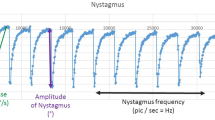Summary
Two-second cathodal current pulses were applied at one-minute intervals at a point external to the round window in the ear of each albino rat subject. Responses were recorded in the vestibular nerve ganglion, the vestibular nuclei (single units), or in the eye movements (search coil recording method) of anaesthetized, decerebrated, or alert rats. The unit responses to the galvanic stimuli were characterized and compared with responses to galvanic and rotational stimuli reported in the literature. The main focus of the study, however, was effects of stimulus repetition. In both the vestibular nerve and vestibular nuclei recordings, the responses of many units were substantially larger or smaller at the end of a 13-pulse stimulus train than at the beginning. In the vestibular nuclei, but not in the nerve, there was a slight bias towards a decrease in response magnitude, with 10/88 units showing decreases great enough to be considered as reflecting an habituation process. In contrast, the eye movement responses showed more consistent response decrements, especially in the alert condition, but also in the other conditions (none of the unit recordings were done in alert rats). It is concluded that some of the modifications underlying habituation of the vestibuloocular reflex probably occur in portions of the neuronal reflex pathways that are downstream from the vestibular nuclei.
Similar content being viewed by others
References
Blanks RHI, Estes MS, Markham CH (1975) Physiologic characteristics of vestibular first order canal neurons in the cat. II. Response to constant angular acceleration. J Neurophysiol 38: 1250–1268
Buettner VW, Büttner V, Henn V (1978) Transfer characteristics of neurons in vestibular nuclei of the alert monkey. J Neurophysiol 41: 1614–1628
Collins WE (1964) Primary, secondary and caloric nystagmus of the cat following habituation to rotation. J Comp Physiol Psychol 57: 417–421
Collins WE (1974) Habituation of vestibular responses with and without visual stimulation. In: Kornhuber HH (ed) Vestibular system, Part 2. Psychophysics, applied aspects and general interpretations. Springer, Berlin Heidelberg New York, pp 369–388
Courjon JH, Clément G, Schmid R (1985) The influence of interstimulus interval on the development of vestibular habituation to repeated velocity steps. Exp Brain Res 59: 10–15
Curthoys IS (1982) The response of primary horizontal semicircular canal neurons in the rat and guinea pig to angular acceleration. Exp Brain Res 47: 286–294
Dodge R (1923) Habituation to rotation. J Exp Psychol 6: 1–35
Fischer AJEM, Huygen PLM, Kuijpers W (1979) Electronystagmography in the laboratory rat. Acta Otolaryngol (Stockh) 88: 412–419
Goldberg JM, Smith CE, Fernandez C (1984) Relation between discharge regularity and responses to externally applied galvanic currents in vestibular nerve afferents of the squirrel monkey. J Neurophysiol 51: 1236–1256
Hess BJM, Precht W, Reber A, Cazin L (1985) Horizontal optokinetic ocular nystagmus in the pigmented rat. Neuroscience 15: 97–107
Horn G (1970) Changes in neuronal activity and their relationship to behaviour. In: Horn G, Hind RA (eds) Short-term changes in neural activity and behaviour. Cambridge University Press, London, pp 567–606
Huizinga E (1930) Untersuchungen über die galvanische Reaktion des Vestibularapparates bei der Taube. Pflügers Arch 224: 569–586
Jäger J, Henn V (1981) Vestibular habituation in man and monkey during sinusoidal rotation. In: Cohen B (ed) Vestibular and oculomotor physiology. Ann NY Acad Sci 374: 330–339
Jeannerod M, Magnin M, Schmid R, Stefanelli M (1976) Vestibular habituation to angular velocity step in the cat. Biol Cybern 22: 39–48
Keller EL, Precht W (1979) Adaptive modification of central vestibular neurons in response to visual stimulation through reversing prisms. J Neurophysiol 42: 896–911
Kileny P, Ryu JH, Mc Cabe BF, Abbas PJ (1980) Neuronal habituation in the vestibular nuclei of the cat. Acta Otolaryngol 90: 175–183
Kornhuber HH, Da Fonsca JS (1964) Optovestibular integration in the cats cortex: a study of sensory convergence on cortical neurons. In: Bender B (ed) The oculomotor system. Harper and Row, New York, pp 239–272
Lisberger SG, Miles FA (1980) Role of primate medial vestibular nucleus in long-term adaptive plasticity of vestibuloocular reflex. J Neurophysiol 43: 1725–1745
Markham CH, Curthoys IS, Yagi T (1978) The influence of contralateral labyrinth on static and dynamic properties of brainstem vestibular neurons in the cat, guinea pig and rat. In: Hood JD (ed) Vestibular mechanisms in health and disease. Academic Press, London, pp 86–94
Melvill Jones G, Milsum JH (1971) Frequency-response analysis of central vestibular unit activity resulting from rotational stimulation of the semi-circular canals. J Physiol (Lond) 219: 191–215
Paxinos G, Watson C (1982) The rat brain in stereotaxic coordinates. Academic Press, Sydney
Pfaltz CR (1969) The diagnostic importance of the galvanic test in otoneurology. Prat Oto-Rhino-Laryngol 31: 193–203
Precht W, Shimazu M (1965) Functional connections of tonic and kinetic vestibular neurons with primary vestibular afferents. J Neurophysiol 28: 1014–1028
Schmid R, Jeannerod M (1985) Vestibular habituation: an adaptative process? In: Berthoz A, Melvill Jones (eds) Adaptative mechanisms in gaze control facts and theories. Elsevier, Amsterdam, pp 113–122
Segundo JP, Bell CC (1970) Habituation of single nerve cells in vertebrate nervous system. In: Horn G, Hinde RA (eds) Short-term changes in neural activity and behavior. Cambridge University Press, London, pp 77–94
Shinoda Y, Yoshida K (1974) Dynamic characteristics of responses to horizontal head angular acceleration in vestibulo-ocular pathways in the cat. J Neurophysiol 37: 653–673
Sirkin DW, Precht W, Courjon JH (1984) Initial, rapid phase of recovery from unilateral vestibular lesion in rat not dependent on survival of central portion of vestibular nerve. Brain Res 302: 245–256
Author information
Authors and Affiliations
Additional information
Prof. Precht died on March 12, 1985
Rights and permissions
About this article
Cite this article
Courjon, J.H., Precht, W. & Sirkin, D.W. Vestibular nerve and nuclei unit responses and eye movement responses to repetitive galvanic stimulation of the labyrinth in the rat. Exp Brain Res 66, 41–48 (1987). https://doi.org/10.1007/BF00236200
Received:
Accepted:
Issue Date:
DOI: https://doi.org/10.1007/BF00236200




